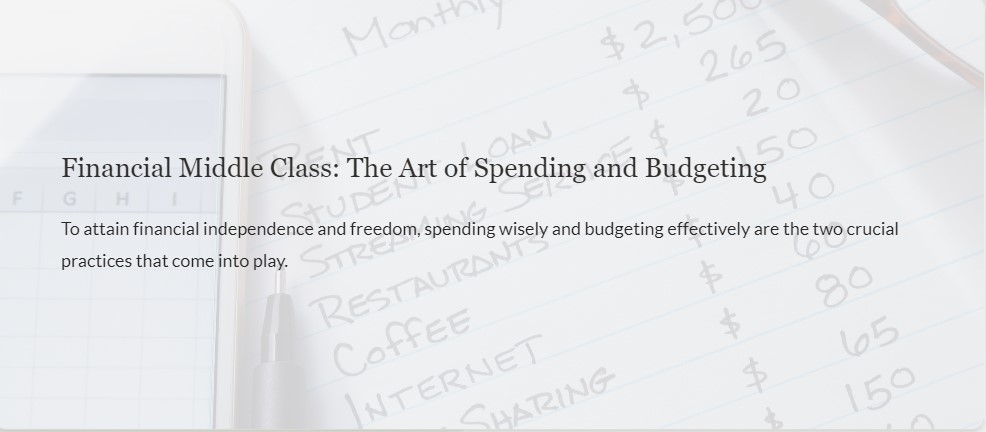Mastering Your Finances: The Art of Spending and Budgeting
An alarming majority of American consumers, comprising nearly 60%, find themselves woefully unprepared to handle a relatively modest $1,000 emergency expense using their existing savings, exposing a concerning vulnerability in their financial resilience and highlighting the pressing need for improved savings habits and financial preparedness.
As a result, achieving financial stability and prosperity has become a top priority for individuals. To attain financial independence and freedom, spending wisely and budgeting effectively are the two crucial practices that come into play.
While these concepts may seem straightforward, mastering them is an art that requires dedication and discipline. This article will delve into the importance of understanding one’s spending habits, breaking down expenses by category, and creating a successful budgeting strategy to ensure financial success.
Understanding Your Spending Habits
The first step in gaining control over your finances is gaining insight into your spending habits. Tracking expenses for at least a month will help identify patterns and evaluate where your money is going.
Common expense categories include essential expenses (housing, groceries, transportation, and health insurance), lifestyle expenses (dining out, entertainment, subscriptions, and personal care), debt payments, and savings and investments.
Breaking Down Your Spending
Breaking down expenses into categories is a critical exercise that unveils the nuances of your financial habits. Doing so lets you identify areas where you may be overspending and make the necessary adjustments.
One way to categorize expenses is by distinguishing between fixed and variable expenses.
Fixed expenses, such as rent or mortgage payments, insurance premiums, and loan repayments, remain relatively constant monthly.
On the other hand, variable expenses fluctuate depending on your lifestyle choices and can include items like groceries, entertainment, and discretionary spending.
Furthermore, understanding discretionary and non-discretionary expenses is essential. Discretionary expenses, such as dining out or leisure activities, are non-essential and can be adjusted more efficiently.
Non-discretionary expenses, such as rent and utilities, are necessary for daily living and are typically harder to reduce.
Creating an Effective Budget
With a comprehensive understanding of spending patterns and categorized expenses, it is time to create an adequate budget. A budget acts as a financial roadmap, guiding your spending decisions and empowering you to achieve your financial goals. Here’s how you can create a successful budget:
Start by determining your short-term and long-term financial objectives. These could include paying off debts, saving for a vacation, or building an emergency fund. Clear goals provide direction and motivation for your financial journey.
Allocate your income into the categories we discussed: essential expenses, lifestyle expenses, debt payments, savings, and investments. This process ensures that your money is allocated efficiently to cover your needs and aspirations.
- Create a Realistic Budget
A successful budget should be realistic and attainable. Avoid setting overly strict restrictions, which may lead to frustration and failure. Instead, balance your financial goals and income to ensure sustainable progress.
Consistent monitoring of your spending habits is crucial to staying within your budget. Utilize budgeting apps or spreadsheets to simplify the process and identify areas for adjustments.
Periodically review your budget to assess its effectiveness. Life circumstances change, and your financial goals might evolve. Be prepared to adjust your budget accordingly to stay on track.
Tips for Successful Budgeting
To enhance the effectiveness of your budget and overall financial management, consider the following tips:
- Prioritize Debt Repayment
Focus on paying off high-interest debts first to save on interest payments over time. This approach will accelerate your journey to becoming debt-free.
Prepare for unforeseen circumstances by saving at least three to six months of living expenses in an easily accessible account. An emergency fund will act as a safety net during challenging times.
Automate savings contributions and consider investing in growing your wealth over time. Compound interest can work wonders for your long-term financial goals.
- Be Mindful of Impulse Spending
Before making impulsive purchases, please take a moment to consider whether they align with your financial goals. Mindful spending will help you avoid unnecessary expenses.
Conclusion
Mastering the art of spending wisely and budgeting effectively is a transformative journey that leads to financial security and freedom.
The foundational steps are understanding your spending habits, breaking down expenses, and creating a realistic budget.
By diligently tracking your finances, reviewing and adjusting your budget, and adhering to sound financial principles, you will be well on your way to achieving your financial goals and attaining a brighter and more prosperous future.
Embrace this art of managing your finances, and you will undoubtedly reap the rewards of financial success.

Pingback: Mounting Credit Card Debt Sends Shockwaves Through U.S. Economy -